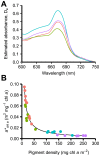Symbiodinium photosynthesis in Caribbean octocorals
- PMID: 25192405
- PMCID: PMC4156329
- DOI: 10.1371/journal.pone.0106419
Symbiodinium photosynthesis in Caribbean octocorals
Abstract
Symbioses with the dinoflagellate Symbiodinium form the foundation of tropical coral reef communities. Symbiodinium photosynthesis fuels the growth of an array of marine invertebrates, including cnidarians such as scleractinian corals and octocorals (e.g., gorgonian and soft corals). Studies examining the symbioses between Caribbean gorgonian corals and Symbiodinium are sparse, even though gorgonian corals blanket the landscape of Caribbean coral reefs. The objective of this study was to compare photosynthetic characteristics of Symbiodinium in four common Caribbean gorgonian species: Pterogorgia anceps, Eunicea tourneforti, Pseudoplexaura porosa, and Pseudoplexaura wagenaari. Symbiodinium associated with these four species exhibited differences in Symbiodinium density, chlorophyll a per cell, light absorption by chlorophyll a, and rates of photosynthetic oxygen production. The two Pseudoplexaura species had higher Symbiodinium densities and chlorophyll a per Symbiodinium cell but lower chlorophyll a specific absorption compared to P. anceps and E. tourneforti. Consequently, P. porosa and P. wagenaari had the highest average photosynthetic rates per cm2 but the lowest average photosynthetic rates per Symbiodinium cell or chlorophyll a. With the exception of Symbiodinium from E. tourneforti, isolated Symbiodinium did not photosynthesize at the same rate as Symbiodinium in hospite. Differences in Symbiodinium photosynthetic performance could not be attributed to Symbiodinium type. All P. anceps (n = 9) and P. wagenaari (n = 6) colonies, in addition to one E. tourneforti and three P. porosa colonies, associated with Symbiodinium type B1. The B1 Symbiodinium from these four gorgonian species did not cluster with lineages of B1 Symbiodinium from scleractinian corals. The remaining eight E. tourneforti colonies harbored Symbiodinium type B1L, while six P. porosa colonies harbored type B1i. Understanding the symbioses between gorgonian corals and Symbiodinium will aid in deciphering why gorgonian corals dominate many Caribbean reefs.
Conflict of interest statement
Figures




Similar articles
-
The effects of elevated seawater temperatures on Caribbean gorgonian corals and their algal symbionts, Symbiodinium spp.PLoS One. 2017 Feb 2;12(2):e0171032. doi: 10.1371/journal.pone.0171032. eCollection 2017. PLoS One. 2017. PMID: 28152002 Free PMC article.
-
Caribbean gorgonian octocorals cope with nutrient enrichment.Mar Pollut Bull. 2019 Apr;141:621-628. doi: 10.1016/j.marpolbul.2019.02.067. Epub 2019 Mar 14. Mar Pollut Bull. 2019. PMID: 30955777
-
Fine-scale diversity and specificity in the most prevalent lineage of symbiotic dinoflagellates (Symbiodinium, Dinophyceae) of the Caribbean.Mol Ecol. 2004 Feb;13(2):459-69. doi: 10.1046/j.1365-294x.2003.02058.x. Mol Ecol. 2004. PMID: 14717900
-
The engine of the reef: photobiology of the coral-algal symbiosis.Front Microbiol. 2014 Aug 22;5:422. doi: 10.3389/fmicb.2014.00422. eCollection 2014. Front Microbiol. 2014. PMID: 25202301 Free PMC article. Review.
-
Symbiodinium-invertebrate symbioses and the role of metabolomics.Mar Drugs. 2010 Sep 30;8(10):2546-68. doi: 10.3390/md8102546. Mar Drugs. 2010. PMID: 21116405 Free PMC article. Review.
Cited by
-
Individual and combined effect of organic eutrophication (DOC) and ocean warming on the ecophysiology of the Octocoral Pinnigorgia flava.PeerJ. 2023 Feb 17;11:e14812. doi: 10.7717/peerj.14812. eCollection 2023. PeerJ. 2023. PMID: 36814959 Free PMC article.
-
The effects of elevated seawater temperatures on Caribbean gorgonian corals and their algal symbionts, Symbiodinium spp.PLoS One. 2017 Feb 2;12(2):e0171032. doi: 10.1371/journal.pone.0171032. eCollection 2017. PLoS One. 2017. PMID: 28152002 Free PMC article.
-
Microbiomes of Caribbean Octocorals Vary Over Time but Are Resistant to Environmental Change.Front Microbiol. 2020 Jun 12;11:1272. doi: 10.3389/fmicb.2020.01272. eCollection 2020. Front Microbiol. 2020. PMID: 32595627 Free PMC article.
-
Linking host morphology and symbiont performance in octocorals.Sci Rep. 2018 Aug 27;8(1):12823. doi: 10.1038/s41598-018-31262-3. Sci Rep. 2018. PMID: 30150781 Free PMC article.
-
Building consensus around the assessment and interpretation of Symbiodiniaceae diversity.PeerJ. 2023 May 2;11:e15023. doi: 10.7717/peerj.15023. eCollection 2023. PeerJ. 2023. PMID: 37151292 Free PMC article.
References
-
- Bayer FM (1961) The shallow-water Octocorallia of the West Indian region. Studies on the Fauna of Curaçao and other Caribbean Islands 12: 1–428.
-
- Cary LR (1918) The Gorgonaceae as a factor in the formation of coral reefs: Carnegie Institution of Washington.
-
- Kinzie I, Robert A (1973) The zonation of West Indian gorgonians. Bull Mar Sci 23: 93–155.
-
- Lasker HR (1985) Prey preferences and browsing pressure of the butterflyfish Chaetodon capistratus on Caribbean gorgonians. Mar Ecol Prog Ser 21: 213–220.
-
- Lasker HR, Coffroth MA, Fitzgerald LM (1988) Foraging patterns of Cyphoma gibbosum on octocorals: the roles of host choice and feeding preference. Biol Bull 174: 254–266.
Publication types
MeSH terms
Substances
LinkOut - more resources
Full Text Sources
Other Literature Sources

